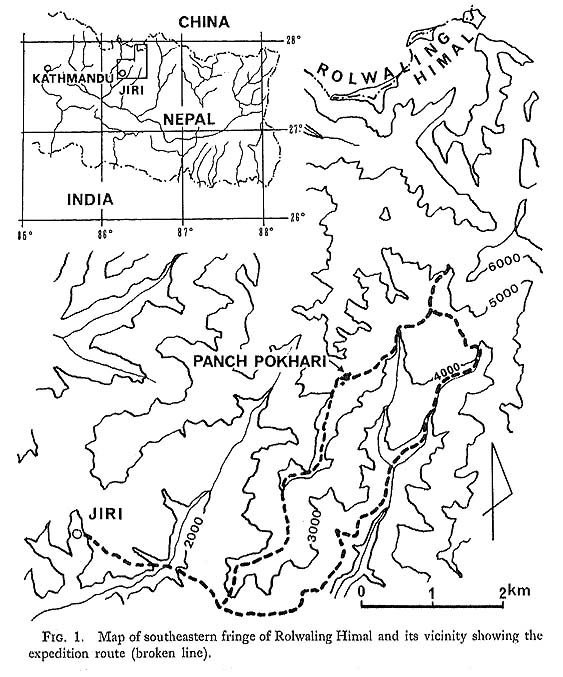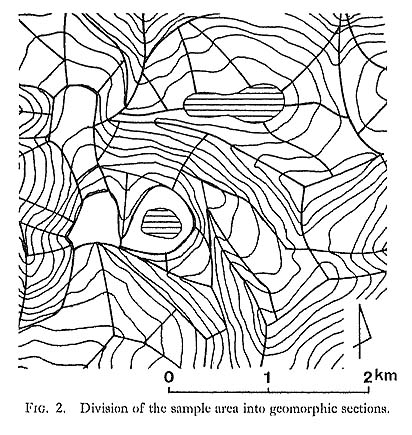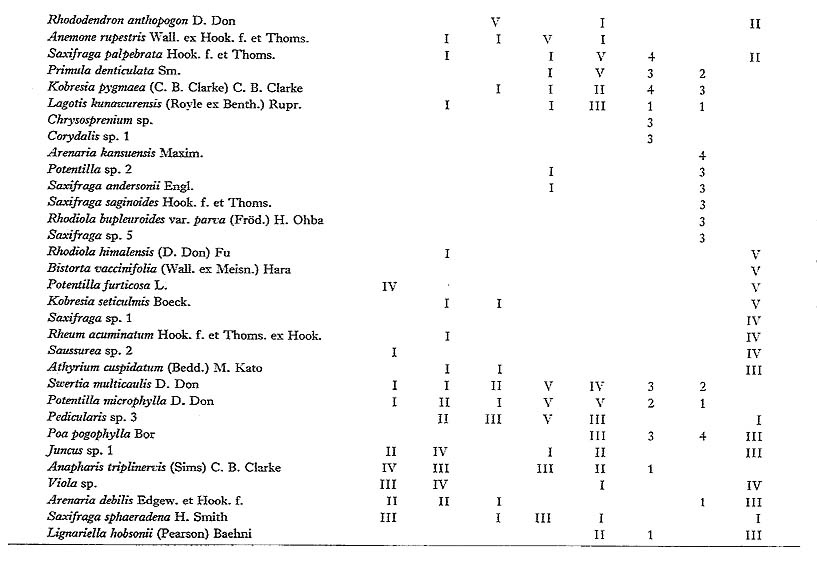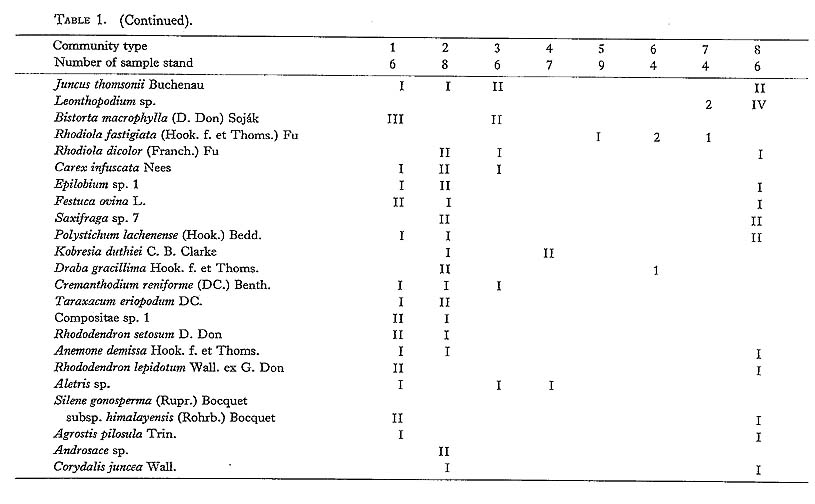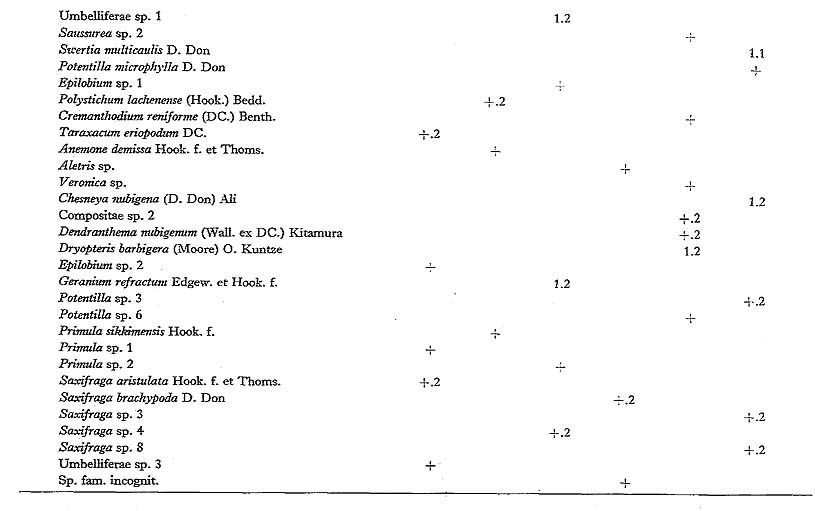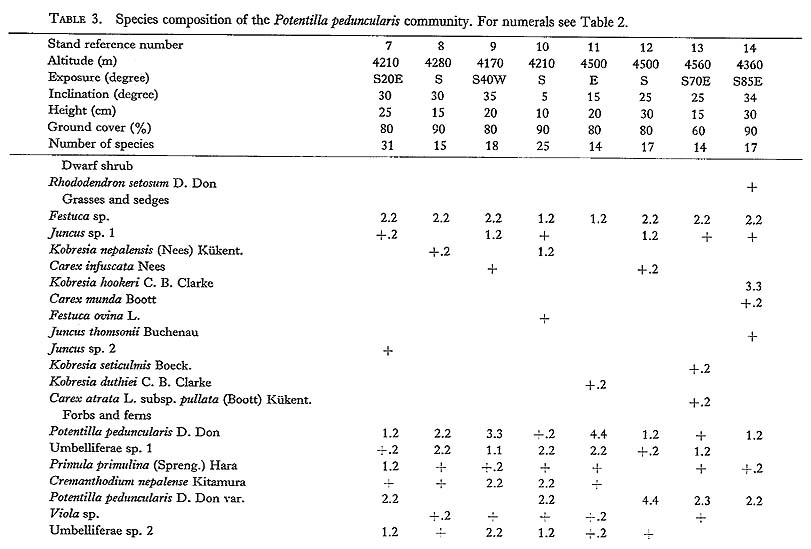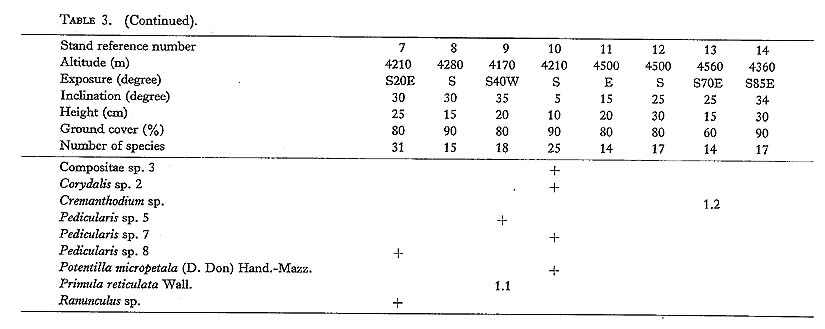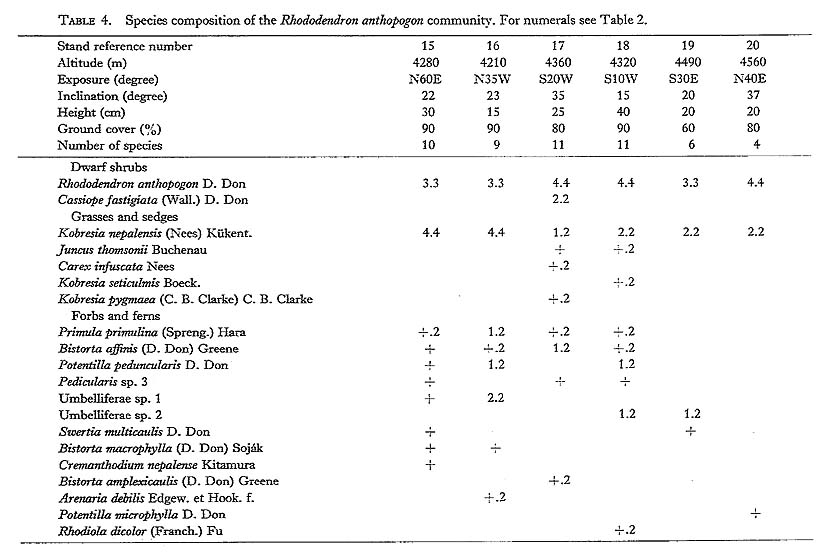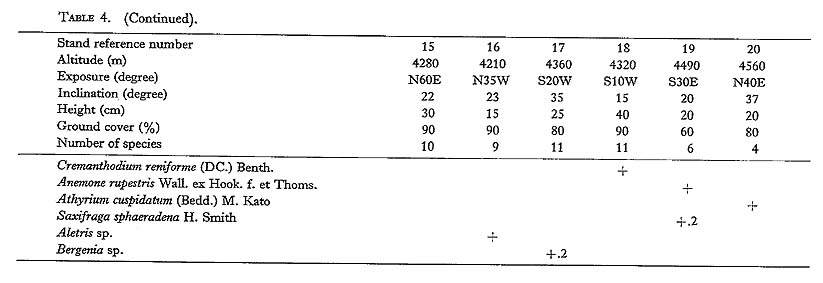PRELIMINARY STUDY OF ALPINE VEGETATION OF THE HIMALAYAS, WITH SPECIAL REFERENCE TO THE SMALL-SCALE DISTRIBUTION PATTERNS OF PLANT COMMUNITIES
Takao KIKUCHI and Hideald OHBA
|
The Himalayas are one of the most representative mountain ranges possessing vastv alpine vegetation and great varieties of alpine plants. However, human activity, particularly the grazing of animals, is very common throughout the alpine zone of the Himalayas, and consequently, alpine vegetation is as important as that in low altitudes as a natural resource in Nepal. Alpine vegetation in the easternmost part of central Nepal was phytosociologically examined with special reference to small-scale distribution patterns of the plant communities. Eight plant communities were distinguished based mainly on species composition. Three of them were meadows dominated by forbs or sedges, particularly several species of Kobresla. Two others were dominated by evergreen or deciduous dwarf scrubs and the remaining three were frost-caused alpine deserts. Vegetational difference between sunny slopes and shadowy slopes was extreme. Moreover, there were also differences between the slopes facing west and those facing east, that is, the frost-caused alpine desert was specifically found on slopes facing west when located in the lower part of the alpine zone. This was prominent throughout the whole area higher than 4,800 m above sea level. The sites with unusual edaphic conditions were covered by particular plant communities. This paper reports our phytosociological findings for major alpine plant communities in the easternmost part of central Nepal; in particular species composition and small-scale and even micro-scale distribution patterns in relation to geomorphic conditions. The results should provide basic information for the natural resource management of the Himalayan alpine zone as well as for pure botany. Area Studied and MethodsThe area studied was on the southeastern fringe of Rolwaling Himal located in the easternmost part of central Nepal (Fig. 1). According to reports on vegetational comparisons by several authors (Haffner, 1981; Shresta, 1982; Numata, 1983; Kojiina, 1985; Ohsawa et al., 1986), vertical distribution patterns of vegetation zones vary from district to district in the Himalayas. In the area covered by the present study, the Abies spectabilis forest was seen up to about 3,800 m above sea level. Above that, Rhododendron campanulatum scrub extended to about 4,000 m. The alpine zone between the upper limit of the Rh. campanulatum scrub and the snow line at about 5,000 m above sea level was examined phytosociologically and the plant communities were classified based mainly on their species composition. A sample area 2 by 2 km was selected near Panch Pokhari Lake for purposes of examining the small-scale distribution pattern of vegetation. It was divided into geomorphic sections each of which consisted of an approximately uniform slope as far as could be estimated by means of a 1: 50,000 scale map(Fig. 2). Then, the prominent formationthe type existing in each section was determined according to observations from a distance using binoculars. The area ranged from 4,100 m to 4,700 m above sea level, and so it did not include the upper part of the alpine zone.
ResultsClassification of Plant CommunitiesBased on the phytoaociological comparison of species composition, the stands investigated in this study were classified into the following eight community types. Their floristic interrelationa are shown in Table 1.
1. The Kohresia hookeri community
2. The Potentilla peduncularis community
3. The Rhododendron anthopogon community
4.The Kobresia nepalensis community
5. The Potentilla micropliylla-Primula denticulata community
6. The Kobresia pygmaea- Chrysosplenium sp. community
7. The Poa pogophylla-Arenaria kansuensis community
8. The Bistorta vaccinifolia community
Among these plant communities, the first four mentioned, i.e., the Kobresia hookeri, Potentilla pedumcularis, Rhododendron anthopogon, and Kobresia nepalensis communities, were classified into one group based on the species they had in common such as Festuca sp., Potentilla peduncularis var., an unidentified species of Umbelliferae, Primula primu lina, Bistorta affinis, Cremanthodium nepalense and Kobresia nepalensis (Table 1). The next three, i.e., the Potentilla micropliylla-Primula denticulata community, the Kobresia pygmaea-Chrysosplenium sp. community and the Poa pogophylla-Arenaria kansuensis community, were classified into another group because species such as Primula denticulata, Lagotis kunawurensis and Kobresia pygmaea were seen in all three communities. The Bistorta vaccinifolia community alone was distinct from the other plant communities in its species composition. Thus, eight plant communities were distinguished in the present study and they were classified into three groups. Small-Scale Distribution, Patterns of the Plant CommunitiesWhen vegetation was examined from a distance using binoculars, three major formation types were distinguishable. One of them was a meadow consisting mainly of the Kobresia hookeri community and the Potentilla peduncularis community. It was charac terized by an abundance of forbs such as Potentilla, Geranium, Pedicularis, although they were accompanied and sometimes dominated by sedges and grasses. The second formation was another type of meadow comprising the Kobresia nepalensis community which was dominated by short sedge accompanied by a few species of forbs. In this paper, the former is called a Potentilla meadow and the latter is called a Kobresia meadow. The other formation was the evergreen dwarf scrub of the Rhododendron anthopogon community. The formation type prominent in each geomorphic section (Fig. 2) was examined and the numbers of the geomorphic sections are shown in Table 10 for every slope exposure of the sections. The Potentilla meadow was prominent in the sections facing south and their vicinities, while the evergreen dwarf scrub was prominent in those facing the opposite direction. The Kobresia meadow was not concentrated in any particular section with specific exposure.
The distribution pattern of each plant community is shown in Fig. 3 based on altitude and exposure at each sample stand. The Kobresia hookeri community and the Potentilla peduncularis community were both found on slopes facing southwest, south and southeast. But the former extended to altitudes up to about 4,800 m, while the latter ranged between 4,170 and 4,560 m. The Rhododendron anthopogon community was also found in the altitudinal range of the foregoing communities, but its habitat faced opposite directions; northwest, north and northeast. The Potentilla microphylla Primula denticulata community and the Kobresia pygmaea-Chrysosplenium sp. community were located on slopes facing north, west and south between 4,380 and 4,570 m. The other three plant communities, the Poa pogophylla-Arenaria kansuensis community, the Kobresia nepalensis community and the Bistorta vaccinifolia community, were independent of slope exposure but they ranged from 4,700 to 4,970 m, 4,490 to 4,570 m and 4,150 to 4,330m, respectively. As a result, the plant communities found in the present study were classified into two categories based on their distribution patterns, those on the sites characterized by certain slope exposure and others independent of slope exposure.
Discussion and ConclusionsThere were two types of plant communities dominated by Kobresia hookeri and K. nepalensis, respectively, among those distinguished in the present study. Moreover, Kobresia pygmaea sometimes dominated the plant communities in frost-caused alpine deserts, and K. nepalensis was also prominent under the shrub layer of the Rhododendron anthopogon community. These major plant communities were common throughout the alpine zone of the area studied. Miehe (1982) reported two types of plant communities dominated by Kobresia in Daulagiri- and Annapurna-Himalaya. Similar plant communities have also been reported on the Tibetan Plateau (Chang, 1981; Li, 1981; Zhang et al., 1981; Hou, 1983). They arc quite important as a natural resource for grazing throughout these regions. As many authors have pointed out (Haffner, 1981; Shrestha, 1982; Kojima, 1985; Ohsawa et al., 1986), the vegetational difference between slopes facing south and those facing north is extreme in the Himalayas. Such a vegetational feature was also obvious in the alpine zone observed in the present study. Sunny slopes were widely occupied by meadows of the Kobresia hookeri community and the Potentilla peduncularis community, while shaded slopes were dominated by the evergreen dwarf scrub of the Rhododendron anthopogon community. However, the habitats of the Potentilla microphylla-Primula denticulata community and the Kobresia pygmaea-Chrysosplenium ap. community were restricted to the slopes facing the west. Consequently, there were other vegetational differences related to slope exposure. In this case, their habitats were characterized as alpine desert caused by peri-glacial phenomena such as frost action, resulting from prevailing west wind in winter. At altitudes higher than 4,800 m above sea level, the effects of frost were prominent throughout the whole area, and the Poa pogophylla-Arenaria kansuensis community was found. Thus, the plant communities in the frost-caused alpine desert were zonally distributed in the upper part of the alpine zone, but they were found in a restricted habitat in the lower part. Distributions of the Kobresia nepalensis community and the Bistorta vaccinifolia community were basically independent from slope exposure. The former occurred on thin soil above the basement, and the latter on stony sites. Distribution of these communities depends on edaphic conditions within an area. Thus, the existence of these eight plant communities in the alpine zone was affected by thermal (altitude), sunlight, wind and edaphic conditions, in relation to small-scale or, partly, micro-scale geomorphic properties of the habitats. References
|
